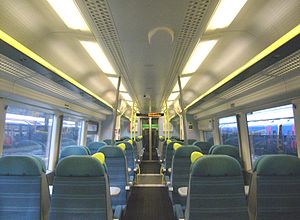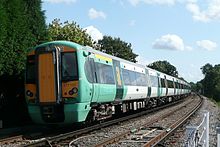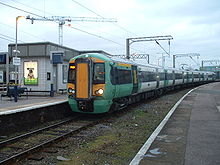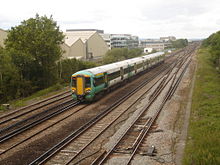- British Rail Class 377
-
British Rail Class 377 "Electrostar"
Southern Class 377/2 no. 377207 at Hemel Hempstead with a service from Milton Keynes Central to South Croydon
The interior of Standard Class aboard a DMCO vehicle in Bombardier Classes 377/4 and 377/5 Electrostar EMU trainsIn service 2002 - Current Manufacturer Bombardier Derby Family name Electrostar Number built 177 trainsets
(excluding 28 375/3 conversions)Number in service 205 trainsets Formation 377/1/2/4/5: 4 cars per set
(DMCO-MSO-PTSO-DMCO)
377/3: 3 cars per set
(DMCO-PTSO-DMCO)Operator Southern
First Capital ConnectSpecifications Car length 20.4 m (66 ft 11 in) Width 2.80 m (9 ft 2 in) Height 3.78 m (12 ft 5 in) Maximum speed 100 mph (161 km/h) Weight 133.1 t (131.0 long tons) (377/3 only)
173.6 t (170.9 long tons) (others)Power output 1 megawatt (1,300 hp) (377/3 only)
1.5 megawatts (2,000 hp) (others)Electric system(s) 750 V DC 3rd rail
25 kV AC Overhead lines (377/2 and 377/5 only)Gauge 1,435 mm (4 ft 8 1⁄2 in) Standard gauge The Class 377 Electrostar is an electric multiple unit type built by Bombardier Transportation (previously ADtranz) at their Derby Works, from 2001 to present. The Electrostar family, which also includes Classes 357, 375, 376, 378, and 379, is the most numerous type of EMU built in the post-privatisation period of Britain's railways. They have become the de facto flagship of the Southern fleet.
Contents
Description
The units are found working suburban services in south London, and rural commuter services to Sussex, Kent and the South Coast, on which they replaced the old 4Cig and 4Vep slam-door stock. Although built in the early 2000s, the new units had a troubled introduction: being fully air-conditioned, their higher power consumption compared to the slam-door Mark 1-based stock that they replaced led to major upgrades being required to the 750 V DC third-rail power supply used in the Southern region.[1] The collapse of Railtrack following the Hatfield accident further delayed this upgrade work and the new stock did not enter squadron service until 2003.
Class 377s are fitted with external CCTV. There is a disabled seating area, and both the intermediate coaches have toilets. Bodyside power doors are electrically operated, a move away from the air powered systems of previous generation EMUs. Dual voltage units are fitted with a Brecknell Willis high speed pantograph, which incorporates a pair of aerofoils on the pan knuckle to steady the pan head against the OLE contact wire. The configuration of a 377/5 unit is:
- DMCO(A) - 2 motors on inner bogie, sander, auxiliary converter module
- MSO - 2 motors on inner bogie, standard toilet
- PTSO - pantograph, transformer, compressor, disabled toilet
- DMCO(B) - 2 motors on inner bogie, sander, auxiliary converter module
Mitrac
Mitrac is the Bombardier Train Management System (TMS). It provides monitoring of on-train systems, fault finding diagnostics, event monitoring and preventative maintenance. In conjunction with the onboard GPS receiver, Mitrac controls Selective Door Operation (SDO), as well as automatic Passenger Information System (PIS) displays and Public Address announcements. Engineers can access the system remotely via GSM to download the fault log, then carry out real time diagnostics whilst the train continues in service.
Couplers
The Class 377 uses Dellner couplers instead of the Tightlock type originally used on Southern's Class 375s. Southern's 375s were all converted to Class 377s - these reclassified units can still be identified due to their blue, grey, and red seating, as opposed to the green seating fitted to Southern's native 377s. Note that Southeastern's 375s (sub-classes 375/3, 375/6, and 375/7) were converted to Dellner couplers but not reclassified; their 375/8 and 375/9 units were fitted with Dellner couplers as built.[2]
Traction current supply
All units can receive power via third-rail pick-up which provides 750 V DC. There are eight pick-up shoes per unit (twice the number of previous generation 4 car Electric multiple units), and this enables them to ride smoothly over most third rail gaps. The shoe mechanism is air-operated, so that when the train switches to AC traction current they are raised out of the way. Some of the units in the 377/2 and 377/5 sub-classes are dual-voltage, and are fitted with a pantograph to pick up 25 kV AC from overhead lines. This is used on the West Coast Main Line between Milton Keynes and South Croydon. Since March 2009 dual-voltage Class 377 sets have also been operating some Thameslink Bedford to Brighton, Gillingham and Ashford services. (see below).
Among the remaining units, the trailer carriage in each unit has a recess in its roof where a pantograph could be fitted, to allow for future conversion to overhead AC power. Despite most units being DC-only, the class is numbered in the 3xx series normally used for AC units.
Southern liveried Bombardier Class 377/2 Electrostar No. 377213 at Watford Junction, with a service bound for Brighton First Capital Connect Bombardier Class 377/5 Electrostar No. 377508 is seen arriving at St. Albans, with a southbound service for Brighton
First Capital Connect Bombardier Class 377/5 Electrostar No. 377508 is seen arriving at St. Albans, with a southbound service for Brighton
Additional units and the Thameslink Programme
In April 2007, as part of the Route Utilisation Strategy for the Brighton Main Line, it was announced that Southern would obtain an additional 48 Class 377 carriages to replace an identical number of Class 319 carriages (12 4-car units) that were due to be transferred to First Capital Connect.[3] Further to this, eleven more dual-voltage units were added to the order, making a total of 23. They were ordered from Bombardier in March 2008 and were delivered in First's corporate colour scheme but with Southern spec interior (green seats).[4] The units were commissioned at Southern's Selhurst depot in South London before being transferred to First Capital Connect's Bedford Cauldwell depot. The first of these, unit 377501, was delivered to Cauldwell depot on 27 February 2009 after making its first appearance through the Thameslink Central London core. The 377/5s operate mainly on the Bedford to Brighton services but in the peaks form part of FCC's and Southeastern's new joint service to places such as Gillingham and Ashford. Once FCC's new passenger vehicles come into service, the 377/5 fleet will be returned to Southern.
Delays in the construction of the Class 377/5s for First Capital Connect saw the temporary transfer of eight of Southern's Class 377/2s to FCC to enable them to implement the planned timetable changes on 22 March 2009; the loss of these units until September 2009 was covered by the temporary cascade of a number of Class 350/1s to Southern from London Midland, which operated services between East Croydon and Milton Keynes.[5]
In September 2011 it was announced that due to delays in the Thameslink Programme stock procurement, the return to Southern of the Class 377/5 fleet would be delayed and therefore 130 additional vehicles would be required by December 2013.[6] It is thought likely that these will be Class 377 vehicles.[6]
Current operations
Southern
- Brighton Main Line: Brighton – Gatwick Airport - London (various destinations)
- East Coastway (Brighton – Eastbourne/Ore)
- West Coastway (Brighton – Portsmouth/Southampton & Littlehampton - London)
- Redhill - Tonbridge (Tonbridge to Redhill, Victoria, London Bridge or Charing Cross)
- West London Line (South Croydon – Milton Keynes Central)
- Sutton & Mole Valley Line (Horsham, Guildford & Epsom Downs to London)
- Caterham & Tattenham Corner branches (selected workings)
First Capital Connect
- Thameslink: (Brighton-Gatwick Airport-London-Luton-Bedford also Bedford to Ashford/Gillingham in peak hours)
Fleet details
Class Type Operator No. Built Year Built Cars per Set Unit nos. Notes Class 377/1 Express Southern 64 2002–2003 4 377101-164 The first 19 units are Brighton-based and used on main-line routes. 377120 to 377157 are now Selhurst-based and used on a mixture of Metro workings, East Grinstead workings and occasional outer suburban workings to Horsham. 377158 to 377164 are Brighton based and used on main line routes. Class 377/2 Express Southern 15 2003–2004 4 377201-215 Dual-voltage units. These are dedicated to the South Croydon - Milton Keynes Central route. Also, occasionally used on London Metro routes.
Class 377/3 Express Southern 28 2001–2002 3 377301-328 Converted from Class 375 Nos. 375311-338 by having their Tightlock couplings replaced by Dellners. These are now mainly used on West Coastway local, Brighton to Southampton, and East Coastway local Seaford line services. From 2010 will transfer to the South London Line and be replaced by 313s. They are the only Class 377 trains to have 3 car sets.
Class 377/4 Outer suburban Southern 75 2003–2005 4 377401-475 Brighton-based covering most main-line routes. Note: Both unit Nos. 377472 and 377474 have 'speed run' branding in reference to these units having formed the record breaking London to Brighton run. Class 377/5 Express First Capital Connect 23 2008–2009 4 377501-523 23 dual-voltage units order by Southern. Sub-leased to FCC as part of the Thameslink Programme Key Output Zero (KO0) Diagram
References
- ^ Roger Ford (May 2003). "Informed Sources". Modern Railways. http://dspace.dial.pipex.com/town/square/ca14/ALYCIDON%20RAIL/INFORMED%20SOURCES%20ARCHIVE/INF%20SRCS%202003/Informed%20Sources%2005%202003%20p4.htm.
- ^ "Southern Electric Fleet Review Summer 2004". Southern Electric Group. 21 April 2006. http://www.southernelectric.org.uk/features/flrvelc.html.
- ^ Department for Transport (2007-04-04). "More trains arriving on busy rail routes". Archived from the original on 2007-07-05. http://web.archive.org/web/20070705181007/http://www.dft.gov.uk/pgr/rail/passenger/franchises/moretrains. Retrieved 2007-07-14.
- ^ Photograph of 377501
- ^ "All Aboard for the latest game of musical trains on the National Network". Railway Herald (169): p. 4. http://www.railwayherald.co.uk/magazine/pdf/RHUK/Issue169.pdf.
- ^ a b "Could Southern be the lifeline for Bombardier?". Railway Herald (284): p. 3. http://railwayherald.co.uk/magazine/pdf/RHUK/Issue284.pdf.
Bombardier Turbostar and Electrostar family Turbostar family: Electrostar family: Categories:- Bombardier multiple units
- British Rail electric multiple units
Wikimedia Foundation. 2010.





